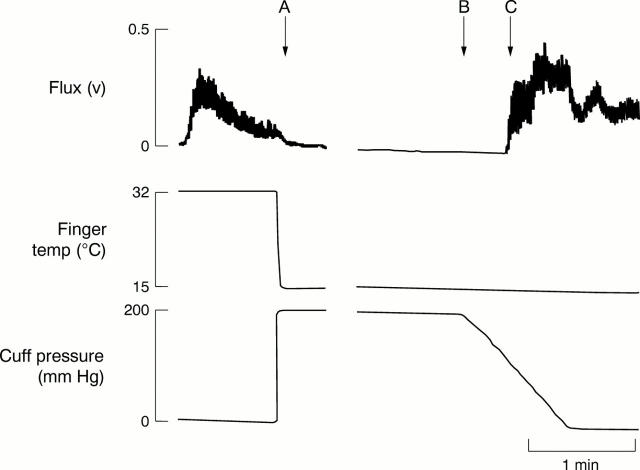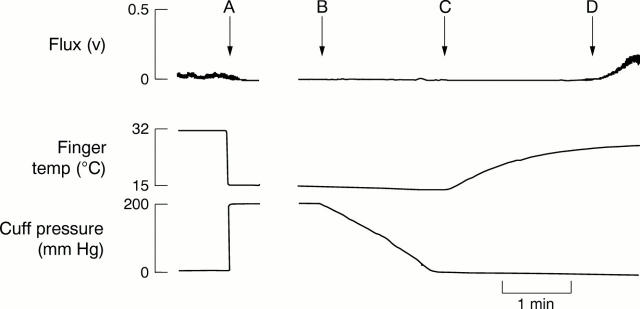Abstract
OBJECTIVE—To determine circulating endothelin-1 levels (ET-1) in patients with primary or secondary associated Raynaud's phenomenon (RP) under resting conditions and in response to cold provocation. METHODS—Patients were categorised as primary RP (18) or scleroderma associated RP (14). Finger blood flow was measured by venous occlusion plethysmography at finger temperatures of 32°C and 24°C. Vasospasm was detected as a finger systolic pressure of 0 mm Hg after standardised provocative cooling. Severity of vasospasm was assessed by the level of cooling required to provoke spasm. Plasma ET-1 levels were measured in antecubital blood withdrawn under baseline conditions (finger 32°C) and at the point of vasospasm. Measurements were also made in 19 matched control subjects. RESULTS—Finger blood flow was lower in patients with RP than in controls, with no difference between the two RP groups. Vasospasm occurred in all patients with RP but not in any control subjects and a grading system of severity was established. Baseline plasma ET-1 levels were similar in patients with RP and controls. Increases in ET-1 levels at the point of vasospasm in patients or corresponding timepoint in controls were also similar. There was no significant difference between the ET-1 levels in the two RP subgroups when the fingers were warm or when vasospasm was present. CONCLUSIONS—These results do not support the hypothesis that ET-1 plays a part in the pathogenesis of RP. Objective testing is a useful adjunct to the clinical diagnosis of RP and allows assignment of a severity grade.
Full Text
The Full Text of this article is available as a PDF (126.9 KB).
Figure 1 .
Measurement of finger systolic pressure after digital cooling in a control subject. The upper trace shows flux in fingertip skin. The middle trace shows temperature around the middle phalanx of the finger. The bottom trace shows pressure in the cuff surrounding the proximal phalanx. A = proximal cuff inflation to 200 mm Hg with simultaneous middle phalangeal cooling to 15°C abolishes flux; B = after five minutes' cooling, gradual cuff deflation; C = return of flux at cuff pressure of 120 mm Hg. Part of the recording during cooling and occlusion between A and B has been omitted.
Figure 2 .
Measurement of finger systolic pressure after digital cooling in a patient with Raynaud's phenomenon. The upper trace shows flux in fingertip skin. The middle trace shows temperature around the middle phalanx of the finger. The bottom trace shows pressure in the cuff surrounding the proximal phalanx. A = proximal cuff inflation to 200 mm Hg with simultaneous middle phalangeal cooling to 15°C abolishes flux; B = after five minutes' cooling, gradual cuff deflation; C = no return of flux when cuff pressure is 0 mm Hg, rewarming started; D = return of flux after digital rewarming. Part of the recording during cooling and occlusion between A and B has been omitted.
Selected References
These references are in PubMed. This may not be the complete list of references from this article.
- Alarcon-Segovia D. Mixed connective tissue disease - a decade of growing pains. J Rheumatol. 1981 Jul-Aug;8(4):535–540. [PubMed] [Google Scholar]
- Allen J. A., Devlin M. A., McGrann S., Doherty C. C. An objective test for the diagnosis and grading of vasospasm in patients with Raynaud's syndrome. Clin Sci (Lond) 1992 May;82(5):529–534. doi: 10.1042/cs0820529. [DOI] [PubMed] [Google Scholar]
- Bach F. H., Robson S. C., Winkler H., Ferran C., Stuhlmeier K. M., Wrighton C. J., Hancock W. W. Barriers to xenotransplantation. Nat Med. 1995 Sep;1(9):869–873. doi: 10.1038/nm0995-869. [DOI] [PubMed] [Google Scholar]
- Brain S. D., Tippins J. R., Williams T. J. Endothelin induces potent microvascular constriction. Br J Pharmacol. 1988 Dec;95(4):1005–1007. doi: 10.1111/j.1476-5381.1988.tb11731.x. [DOI] [PMC free article] [PubMed] [Google Scholar]
- Cimminiello C., Milani M., Uberti T., Arpaia G., Perolini S., Bonfardeci G. Endothelin, vasoconstriction, and endothelial damage in Raynaud's phenomenon. Lancet. 1991 Jan 12;337(8733):114–115. doi: 10.1016/0140-6736(91)90772-h. [DOI] [PubMed] [Google Scholar]
- Fyhrquist F., Saijonmaa O., Metsärinne K., Tikkanen I., Rosenlöf K., Tikkanen T. Raised plasma endothelin-I concentration following cold pressor test. Biochem Biophys Res Commun. 1990 May 31;169(1):217–221. doi: 10.1016/0006-291x(90)91456-3. [DOI] [PubMed] [Google Scholar]
- Hocher B., Thöne-Reineke C., Bauer C., Raschack M., Neumayer H. H. The paracrine endothelin system: pathophysiology and implications in clinical medicine. Eur J Clin Chem Clin Biochem. 1997 Mar;35(3):175–189. [PubMed] [Google Scholar]
- Kahaleh M. B. Endothelin, an endothelial-dependent vasoconstrictor in scleroderma. Enhanced production and profibrotic action. Arthritis Rheum. 1991 Aug;34(8):978–983. doi: 10.1002/art.1780340807. [DOI] [PubMed] [Google Scholar]
- Kallenberg C. G., Wouda A. A., The T. H. Systemic involvement and immunologic findings in patients presenting with Raynaud's phenomenon. Am J Med. 1980 Nov;69(5):675–680. doi: 10.1016/0002-9343(80)90417-9. [DOI] [PubMed] [Google Scholar]
- Kanno K., Hirata Y., Emori T., Ohta K., Shichiri M., Shinohara S., Chida Y., Tomura S., Marumo F. Endothelin and Raynaud's phenomenon. Am J Med. 1991 Jan;90(1):130–132. doi: 10.1016/0002-9343(91)90519-4. [DOI] [PubMed] [Google Scholar]
- LeRoy E. C., Black C., Fleischmajer R., Jablonska S., Krieg T., Medsger T. A., Jr, Rowell N., Wollheim F. Scleroderma (systemic sclerosis): classification, subsets and pathogenesis. J Rheumatol. 1988 Feb;15(2):202–205. [PubMed] [Google Scholar]
- LeRoy E. C., Medsger T. A., Jr Raynaud's phenomenon: a proposal for classification. Clin Exp Rheumatol. 1992 Sep-Oct;10(5):485–488. [PubMed] [Google Scholar]
- Levin E. R. Endothelins. N Engl J Med. 1995 Aug 10;333(6):356–363. doi: 10.1056/NEJM199508103330607. [DOI] [PubMed] [Google Scholar]
- Maricq H. R., Weinrich M. C. Diagnosis of Raynaud's phenomenon assisted by color charts. J Rheumatol. 1988 Mar;15(3):454–459. [PubMed] [Google Scholar]
- Maricq H. R., Weinrich M. C., Valter I., Palesch Y. Y., Maricq J. G. Digital vascular responses to cooling in subjects with cold sensitivity, primary Raynaud's phenomenon, or scleroderma spectrum disorders. J Rheumatol. 1996 Dec;23(12):2068–2078. [PubMed] [Google Scholar]
- McGrann S., Irwin S. T., Allen J. A. A plethysmograph for the measurement of digital blood flow. J Med Eng Technol. 1986 Nov-Dec;10(6):329–331. doi: 10.3109/03091908609022926. [DOI] [PubMed] [Google Scholar]
- Ohlstein E. H., Elliott J. D., Feuerstein G. Z., Ruffolo R. R., Jr Endothelin receptors: receptor classification, novel receptor antagonists, and potential therapeutic targets. Med Res Rev. 1996 Jul;16(4):365–390. doi: 10.1002/(SICI)1098-1128(199607)16:4<365::AID-MED4>3.0.CO;2-V. [DOI] [PubMed] [Google Scholar]
- Smits P., Hofman H., Rosmalen F., Wollersheim H., Thien T. Endothelin-1 in patients with Raynaud's phenomenon. Lancet. 1991 Jan 26;337(8735):236–236. doi: 10.1016/0140-6736(91)92198-b. [DOI] [PubMed] [Google Scholar]
- Yamane K., Miyauchi T., Suzuki N., Yuhara T., Akama T., Suzuki H., Kashiwagi H. Significance of plasma endothelin-1 levels in patients with systemic sclerosis. J Rheumatol. 1992 Oct;19(10):1566–1571. [PubMed] [Google Scholar]
- Yanagisawa M., Kurihara H., Kimura S., Tomobe Y., Kobayashi M., Mitsui Y., Yazaki Y., Goto K., Masaki T. A novel potent vasoconstrictor peptide produced by vascular endothelial cells. Nature. 1988 Mar 31;332(6163):411–415. doi: 10.1038/332411a0. [DOI] [PubMed] [Google Scholar]
- Zamora M. R., O'Brien R. F., Rutherford R. B., Weil J. V. Serum endothelin-1 concentrations and cold provocation in primary Raynaud's phenomenon. Lancet. 1990 Nov 10;336(8724):1144–1147. doi: 10.1016/0140-6736(90)92766-b. [DOI] [PubMed] [Google Scholar]




